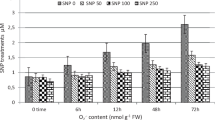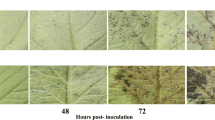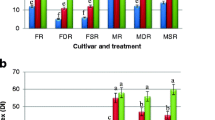Abstract
In our experimental approach we investigated how post-infection nitric oxide-dependent signaling activated in potato leaves was related to defense against avirulent (avr) and virulent (vr) races of Phytophthora infestans. Results revealed that only in an incompatible response, early NO and superoxide (O2 •-) generation led to peroxynitrite (ONOO−) formation and together with hydrogen peroxide (H2O2) production synchronized with SOD activity induced effective defense against avr pathogen. Early oxidative and nitrosative bursts triggered an imbalance in redox homeostasis in inoculated tissue. To counteract that effect, a total antioxidative capacity, ascorbate and sulfhydryl (-SH) group compounds increased both synergistically and markedly, confirming the precise mechanism of redox re-adjustment in avr oomycete -potato interaction. Moreover, the NO-coded message was stored and converted into an enhanced total SNO pool and particular S-nitrosylation of targeted proteins. Overall, we identified 104 proteins typed for S-nitrosylation in mock- or P. infestans-inoculated potato leaves. The S-nitrosoproteome structure comprised a wide repertoire of proteins, i.e. defense- and redox-related. Finally, only in the incompatible interaction, NO-based signal was re-written on the rapid PR-1 gene and PR-2 protein activation and was tuned with a limitation of late blight disease symptoms.




Similar content being viewed by others
References
Abat, J. K., Mattoo, A. K., & Deswal, R. (2008). S-nitrosylated proteins of a medicinal CAM plant Kalanchoe pinnata- ribulose-1,5-bisphosphate carboxylase/oxygenase activity targeted for inhibition. FEBS Journal, 275, 2862–2872.
Abeles, F., & Forrence, L. (1970). Temporal and Hormonal Control of β-1,3-Glucanase in Phaseolus vulgaris L. Plant Physiology, 45, 395–400.
Able, A. J., Guest, D. I., & Sutherland, M. W. (1998). Use of a new tetrazolium-based assay to study the production of superoxide radicals by tobacco cell cultures challenged with avirulent zoospores of Phytophthora parasitica var nicotianae. Plant Physiology, 117, 491–499.
Arasimowicz-Jelonek, M., & Floryszak-Wieczorek, J. (2011). Understanding the fate of peroxynitrite in plant cells–from physiology to pathophysiology. Phytochemistry, 72, 681–688.
Arasimowicz-Jelonek, M., & Floryszak-Wieczorek, J. (2014). Nitric oxide: an effective weapon of the plant or the pathogen? Molecular Plant Patholology, 15(4), 406–416.
Arasimowicz-Jelonek, M., Floryszak-Wieczorek, J., Drzewiecka, K., Chmielowska-Bąk, J., Abramowski, D., & Izbiańska, K. (2014a). Aluminum induces cross-resistance of potato to Phytophthora infestans. Planta, 239, 679–694.
Arasimowicz-Jelonek, M., Floryszak-Wieczorek, J., Abramowski, D., Izbiańska, K. (2014b) Nitric oxide and reactive nitrogen species. In: nitric oxide in plants: metabolism and role ins tress physiology. Springer International Publishing, pp 165–184.
Astier, J., Rasul, S., Koen, E., Manzoor, H., Besson-Bard, A., Lamotte, O., Jeandroz, S., Durner, J., Lindermayr, C., & Wendehenne, D. (2011). S-nitrosylation: an emerging post-translational protein modification in plants. Plant Science: An International Journal of Experimental Plant Biology, 181, 527–533.
Barroso, J. B., Corpas, F. J., Carreras, A., Rodríguez-Serrano, M., Esteban, F. J., Fernández-Ocaňa, A., Chaki, M., Romero-Puertas, M. C., Valderrama, R., Sandalio, L. M., & del Río, L. A. (2006). Localization of S-nitrosoglutathione and expression of S-nitrosoglutathione reductase in pea plants under cadmium stress. Journal of Experimental Botany, 57, 1785–1793.
Beauchamp, C., & Fridovich, I. (1971). Superoxide dismutase: improved assays and an assay applicable to acrylamide gels. Analytical Biochemistry, 44, 276–287.
Becana, M., Aparicio-Tejo, P., Irigoyen, J. J., & Sanchez-Diaz, M. (1986). Some enzymes of hydrogen peroxide metabolism in leaves and root nodules of Medicago sativa. Plant Physiology, 82, 1169–1171.
Bennett, M., Mehta, M., & Grant, M. (2005). Biophoton imaging: a nondestructive method for assaying R gene responses. Molecular Plant-Microbe Interactions, 18, 95–102.
Besson-Bard, A., Griveau, S., Bedioui, F., & Wendehenne, D. (2008). Real-time electrochemical detection of extracellular nitric oxide in tobacco cells exposed to cryptogein, an elicitor of defence responses. Journal of Experimental Botany, 59, 3407–3414.
Chaki M., Lindermayr C. (2014) S-Nitrosoglutathione Reductase: Key Regulator of Plant Development and Stress Response. In: Khan MN, Mobin M, Mohammad F, Corpas FJ (eds) Nitric oxide in plants: metabolism and role in stress physiology. Springer International Publishing, pp 139–151.
Chaki, M., Fernández-Ocaňa, A. M., Valderrama, R., Carreras, A., Esteban, F. J., Luque, F., Gómez-Rodrígez, M. V., Begara-Morales, J. C., Corpas, F. J., & Barroso, J. B. (2009). Involvement of reactive nitrogen and oxygen species (RNS and ROS) in sunflower-mildew interaction. Plant and Cell Physiology, 50, 265–279.
Chomcznski, P., & Sacchi, N. (1987). Single-step method of RNA isolation by acid quanidinium thiocyanate-phenol-chloroform extraction. Analytical Biochemistry, 162, 156.
Corpas, F. J., Palma, J. M., Del Río, L. A., & Barroso, J. B. (2013). Protein tyrosine nitration in higher plants grown under natural and stress conditions. Frontiers in Plant Science, 4, 29.
Delledonne, M., Xia, Y., Dixon, R. A., & Lamb, C. (1998). Nitric oxide functions as a signal in plant disease resistance. Nature, 394, 585–588.
Delledonne, M., Zeier, J., Marocco, A., & Lamb, C. (2001). Signal interactions between nitric oxide and reactive oxygen intermediates in the plant hypersensitive disease resistance response. Proceedings of the National Academy of Sciences, 98, 13454–13459.
Doke, N. (1983). Involvement of superoxide anion generation in the hypersensitive response of potato tuber tissues to infection with an incompatible race of Phytophthora infestans and to the hyphal wall components. Physiologial Plant Pathology, 23, 345–357.
Dubreuil-Maurizi, C., Vitecek, J., Marty, L., Branciard, L., Frettinger, P., Wendehenne, D., Meyer, A. J., Mauch, F., & Poinssot, B. (2011). Glutathione deficiency of the Arabidopsis mutant pad2-1 affects oxidative stress-related events, defense gene expression, and the hypersensitive response. Plant Physiology, 157, 2000–2012.
Fares, A., Rossignol, M., & Peltier, J. B. (2011). Proteomics investigation of endogenous S-nitrosylation in Arabidopsis. Biochemical and Biophysical Research Communications, 416(3-4), 331–336.
Fares, A., Nespoulous, C., Rossignol, M., & Peltier, J.-B. (2014). Simultaneous identification and quantification of nitrosylation sites by combination of biotin switch and ICAT labeling. Methods in Molecular Biology, 1072, 609–620.
Feechan, A., Kwon, E., Yun, B.-W., Wang, Y., Pallas, J. A., & Loake, G. J. (2005). A central role for S-nitrosothiols in plant disease resistance. Proceedings of the National Academy of Sciences of the United States of America, 102(22), 8054–8059.
Floryszak-Wieczorek, J., Górski, W., & Arasimowczi-Jelonek, M. (2011). Functional imaging of biophoton responses of plants to fungal infection. European Journal of Plant Pathology, 130, 249–258.
Floryszak-Wieczorek, J., Arasimowicz-Jelonek, M., Milczarek, G., Janus, L., Pawlak-Sprada, S., Abramowski, D., Deckert, J., & Billert, H. (2012). Nitric oxide–mediated stress imprint in potato as an effect of exposure to a priming agent. Molecular Plant-Microbe Interactions, 25, 1469–1477.
Floryszak-Wieczorek J., Arasimowicz-Jelonek M., Abramowski D. (2013) Redox-sensing responses in the potato-Phtophthora infestans system. Oxidative stress and cell death in plants: mechanisms and implications Florence, Italy, p. 53.
Groß, F., Durner, J., & Gaupels, F. (2013). Nitric oxide, antioxidants and prooxidants in plant defence responses. Frontiers in Plant Science, 4, 419.
Hoang, C. V., & Chapman, K. D. (2002). Biochemical and molecular inhibition of plastidial carbonic anhydrase reduces the incorporation of acetate into lipids in cotton embryos and tobacco cell suspensions and leaves. Plant Physiology, 128, 1417–1427.
Holzmeister, C., Gaupels, F., Geerlof, A., Sarioglu, H., Sattler, M., Durner, J., & Lindermayr, C. (2015). Differential inhibition of Arabidopsis superoxide dismutases by peroxynitrite-mediated tyrosine nitration. Journal of Experimental Botany, 66(3), 989–999.
Huang, J., Li, D., Diao, J., Hou, J., Yuan, J., & Zou, G. (2007). A novel fluorescent method for determination of peroxynitrite using folic acid as a probe. Talanta, 72, 1283–1287.
James, W. C. (1971). An illustrated series of assessment keys for plant diseases, their preparation and usage. Canadian Plant Disease Survey, 51, 39–65.
Janus, Ł., Milczarek, G., Arasimowicz-Jelonek, M., Abramowski, D., Billert, H., & Floryszak-Wieczorek, J. (2013). Normoergic NO-dependent changes, triggered by a SAR inducer in potato, create more potent defense responses to Phytophthora infestans. Plant Science, 211, 23–34.
Kato, H., Takemoto, D., & Kawakita, K. (2013). Proteomic analysis of S-nitrosylated proteins in potato plant. Physiologia Plantarum, 148, 371–386.
Kovacs, I., & Lindermayr, C. (2013). Nitric oxide-based protein modification: formation and site-specificity of protein S-nitrosylation. Frontiers in Plant Science, 4, 137.
Lim, M. H., Xu, D., & Lippard, S. J. (2006). Visualization of nitric oxide in living cells by a copper-based fluorescent probe. Nature Chemical Biology, 2, 375–380.
Lindermayr, C., Saalbach, G., & Durner, J. (2005). Proteomic Identification of S-Nitrosylated Proteins in Arabidopsis. Plant Physiology, 137, 921–930.
Malik, S. I., Hussain, A., Yun, B.-W., Spoel, S. H., & Loake, G. J. (2011). GSNOR-mediated de-nitrosylation in the plant defence response. Plant Science, 181, 540–544.
Mukherjee, S. P., & Choudhuri, M. A. (1983). Implications of water stress-induced changes in the levels of endogenous ascorbic acid and hydrogen peroxide in Vigna seedlings. Physiologia Plantarum, 58, 166–170.
Mur, L. A. J., Santosa, I. E., Laarhoven, L. J. J., Holton, N. J., Harren, F. J. M., & Smith, A. R. (2005). Laser photoacoustic detection allows in planta detection of nitric oxide in tobacco following challenge with avirulent and virulent Pseudomonas syringae Pathovars. Plant Physiology, 138, 1247–1258.
Noctor, G., Mhamdi, A., Chaouch, S., Han, Y., Neukermans, J., Marquez-Garcia, B., Queval, G., & Foyer, C. H. (2012). Glutathione in plants: an integrated overview. Plant, Cell & Environment, 35, 454–484.
Noirot, E., Der, C., Lherminier, J., Robert, F., Moricova, P., Kieu, K., Leborgne-Castel, N., Simon-Plas, F., & Bouhidel, K. (2014). Dynamic changes in the subcellular distribution of the tobacco ROS-producing enzyme RBOHD in response to the oomycete elicitor cryptogein. Journal of Experimental Botany, 65, 5011–5022.
Noritake, T., Kawakita, K., & Doke, N. (1996). Nitric oxide induces phytoalexin accumulation in potato tuber tissues. Plant Cell Physiology, 37, 113–116.
Ortega-Galisteo, A. P., Rodriguez-Serrano, M., Pazmino, D. M., Gupta, D. K., Sandalio, L. M., & Romero-Puertas, M. C. (2012). S-Nitrosylated proteins in pea (Pisum sativum L.) leaf peroxisomes: changes under abiotic stress. Journal of Experimental Botany, 63, 2089–2103.
Palmieri, M. C., Lindermayr, C., Bauwe, H., Steinhauser, C., & Durner, J. (2010). Regulation of plant glycine decarboxylase by s-nitrosylation and glutathionylation. Plant Physiology, 152(3), 1514–1528.
Pauly, M., Andersen, L. N., Kauppinen, S., Kofod, L. V., York, W. S., Albersheim, P., & Darvill, A. (1999). A xyloglucan-specific endo-beta-1,4-glucanase from Aspergillus aculeatus: expression cloning in yeast, purification and characterization of the recombinant enzyme. Glycobiology, 9, 93–100.
Pfaffl, M. W. (2001). A new mathematical model for relative quantification in real-time RT-PCR. Nucleic Acids Research, 29, 2004–2007.
Re, R., Pellegrini, N., Proteggente, A., Pannala, A., Yang, M., & Rice-Evans, C. (1999). Antioxidant activity applying an improved ABTS radical cation decolorization assay. Free Radical Biology & Medicine, 26, 1231–1237.
Rice-Evans, C. A., Diplock, A. T., & Symons, M. C. R. (1991). Techniques in free radical research. Laboratory Techniques in Biochemistry and Molecular Biology, 22, 143–147.
Romero-Puertas, M. C., Laxa, M., Matte, A., Zaninotto, F., Finkemeier, I., Jones, A. M. E., Perazzolli, M., Vandelle, E., Dietz, K.-J., & Delledonne, M. (2007). S-Nitrosylation of peroxiredoxin ii e promotes peroxynitrite-mediated tyrosine nitration. The Plant Cell, 19, 4120–4130.
Rustérucci, C., Espunya, M. C., Díaz, M., Chabannes, M., & Martínez, M. C. (2007). S-Nitrosoglutathione reductase affords protection against pathogens in Arabidopsis, both locally and systemically. Plant Physiology, 143, 1282–1292.
Sehrawat A., Abat J.K., Deswal R. (2013) RuBisCO depletion improved proteome coverage of cold responsive S-nitrosylated targets in Brassica juncea. Frontiers in Plant Science, 4, doi:10.3389/fpls.2013.00342.
Spadaro, D., Yun, B.-W., Spoel, S. H., Chu, C., Wang, Y.-Q., & Loake, G. J. (2010). The redox switch: dynamic regulation of protein function by cysteine modifications. Physiologia Plantarum, 138, 360–371.
Stefano, M., Vandelle, E., Polverari, A., Ferrarini, A., & Delledonne, M. (2006). Nitric oxide-mediated signaling functions during the plant hypersensitive response. In L. Lamattina & J. C. Polacco (Eds.), Nitric oxide in plant growth (pp. 207–222). Berlin, Heidelberg: Development and Stress Physiology. Springer Berlin Heidelberg.
Tada, Y., Spoel, S. H., Pajerowska-Mukhtar, K., Mou, Z., Song, J., Wang, C., Zuo, J., & Dong, X. (2008). Plant immunity requires conformational changes of NPR1 via S-nitrosylation and thioredoxins. Science, 321, 952–956.
Tanou, G., Job, C., Rajjou, L., Arc, E., Belghazi, M., Diamantidis, G., Molassiotis, A., & Job, D. (2009). Proteomics reveals the overlapping roles of hydrogen peroxide and nitric oxide in the acclimation of citrus plants to salinity. Plant Journal, 60(5), 795–804.
Tanou, G., Job, C., Belghazi, M., Molassiotis, A., Diamantidis, G., & Job, D. (2010). Proteomic signatures uncover hydrogen peroxide and nitric oxide cross-talk signaling network in citrus plants. Journal of Proteome Research, 2010(11), 5994–6006.
Vanzo, E., Ghirardo, A., Merl-Pham, J., Lindermayr, C., Heller, W., Hauck, S. M., Durner, J., & Schnitzler, J.-P. (2014). S-Nitroso-proteome in poplar leaves in response to acute ozone stress. PLoS ONE, 9(9), e106886. doi:10.1371/journal.pone.0106886.
Vleeshouwers, V. G. A. A., & Oliver, R. P. (2014). Effectors as tools in disease resistance breeding against biotrophic, hemibiotrophic, and necrotrophic plant pathogens. Molecular Plant-Microbe Interactions, 27, 196–206.
Vleeshouwers, V. G., van Dooijeweert, W., Govers, F., Kamoun, S., & Colon, L. T. (2000). The hypersensitive response is assiociated with host and non-host resistance to Phytophthora infestans. Planta, 210, 853–864.
Wang, X., El Hadrami, A., Adam, L. R., & Daayf, F. (2008a). Differential activation and suppression of potato defence responses by Phytophthora infestans isolates representing US-1 and US-8 genotypes. Plant Pathology, 57, 1026–1037.
Wang, Y.-Q., Feechan, A., Yun, B.-W., Shafiei, R., Hofmann, A., Taylor, P., Xue, P., Yang, F.-Q., Xie, Z.-S., Pallas, J. A., Chu, C.-C., & Loake, G. J. (2008b). S-Nitrosylation of AtSABP3 antagonizes the expression of plant immunity. Journal of Biological Chemistry, 284, 2131–2137.
Wilson, U. E., Coffey M. D. (1980). Cytological evaluation of general resistance to Phytophthora infestans in potato foliage. Annals of Botany, 45, 81–90.
Xiong, Y., DeFraia, C., Williams, D., Zhang, X., & Mou, Z. (2009). Characterization of Arabidopsis 6-phosphogluconolactonase T-DNA insertion mutants reveals an essential role for the oxidative section of the plastidic pentose phosphate pathway in plant growth and development. Plant & Cell Physiology, 50, 1277–1291.
Ye, J., Coulouris, G., Zaretskaya, I., Cutcutache, I., Rozen, S., & Madden, T. L. (2012). Primer-BLAST: a tool to design target-specific primers for polymerase chain reaction. BMC Bioinformatics, 13, 134.
Yu, M., Lamattina, L., Spoel, S. H., & Loake, G. J. (2014). Nitric oxide function in plant biology: a redox cue in deconvolution. New Phytologist, 202, 1142–1156.
Yun, B.-W., Feechan, A., Yin, M., Saidi, N. B. B., Le Bihan, T., Yu, M., Moore, J. W., Kang, J.-G., Kwon, E., Spoel, S. H., Pallas, J. A., & Loake, G. J. (2011). S-nitrosylation of NADPH oxidase regulates cell death in plant immunity. Nature, 478, 264–268.
Zhao, S., & Fernald, R. D. (2005). Comprehensive algorithm for quantitative real-time polymerase chain reaction. Journal of Computational Biology, 12, 1047–1064.
Acknowledgments
This study was funded from the National Science Centre (Preludium - grant number 2011/03/N/NZ9/00290). D. Abramowski would like to thank Dr. Christian Lindermayr, Institute of Biochemical Plant Pathology, Helmholtz Zentrum München, for advice in the biotin-switch assay.
Conflict of Interest
The authors declare that they have no conflict of interest.
Author information
Authors and Affiliations
Corresponding author
Appendixes
Appendixes
Late blight disease progress in potato leaves-excised discs inoculated with avr and vr P. infestans. Average area of P. infestans mycelium growth was 2.98 ± 0.17 % in avr P. infestans-treated potato; and 20.1 ± 1.6 % in vr P. infestans-treated potato. Values represent the average of data ± SD of six independent experiments with maintained randomization
Identification of S-nitrosylation targets in potato leaves: a immunodetection of S-nitrosylated proteins with the indication of the bands subjected to densytometric analysis, b negative and positive controls in BST, c protein content visualization using Coomassie blue staining, d functional categorization of the 104 identified S-nitrosylated proteins in potato leaves
Rights and permissions
About this article
Cite this article
Abramowski, D., Arasimowicz-Jelonek, M., Izbiańska, K. et al. Nitric oxide modulates redox-mediated defense in potato challenged with Phytophthora infestans . Eur J Plant Pathol 143, 237–260 (2015). https://doi.org/10.1007/s10658-015-0677-9
Accepted:
Published:
Issue Date:
DOI: https://doi.org/10.1007/s10658-015-0677-9






